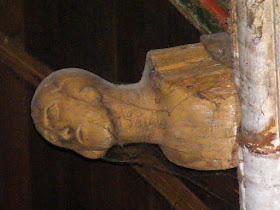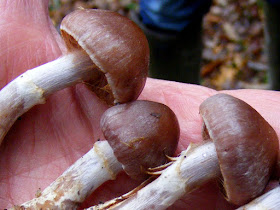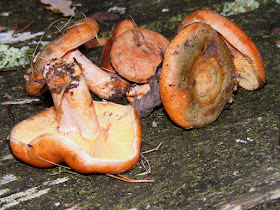14th century window above the altar.
Left, Jean III d'Harcourt, spouse of the founder, probably holding the Eglise des Cordeliers de Bourges. Right, the three sons of Alix de Brabant and Jean III, shown as knights in their colours, red and yellow.
14th century window above the altar.
Right, Alix de Brabant, the founder of the chapter and collegiate church with its bells, with Saint Solange, patron saint of Berry. Below is a coat of arms, half Harcourt, half Brabant.
The border of alternating yellow and white owls on these windows is striking. When you look at them closely they don't really look like owls, yet as soon as you see them you know they are owls. Intriguing. These windows were clearly very old, and appear to be quite badly scratched.
16th century window in the Chapelle d'Anjou.
Top left, René d'Anjou and his two sons Nicolas and Louis. Middle left, Antoinette de Chabannes, wife of René d'Anjou, and their daughters. Bottom left, coat of arms of René d'Anjou. Top right, Saint René, Bishop. Middle right, Saint Anthony and his pig. Bottom right, coat of arms of Antoinette de Chabannes.
16th century window in the Chapelle d'Anjou.
Top left, Nicolas d'Anjou and his son, Nicolas II. Middle left, Gabrielle de Mareuil, Nicolas d'Anjou's wife and their daughters, including Renée, who married François de Bourbon de Montpensier. Bottom left, the coat of arms of Nicolas d'Anjou. Top right, Saint Nicholas and three children. Middle right, Saint Gabriel. Bottom right, the coat of arms of Gabrielle de Mareuil.
16th century window in the Chapelle d'Anjou.
Top left, Louis d'Anjou and his two sons, Louis and René. Middle left, Anne de la Tremouille, wife of Louis d'Anjou, and their daughters Anne and Renée. Bottom left, coat of arms of Louis d'Anjou. Top right, Saint Louis, with crown, sceptre and
main de justice (a sceptre known as the 'Hand of Justice). Middle right, Saint Anne with the Virgin Mary and the Infant Jesus. Bottom right, coat of arms of Anne de la Tremouille.
To see some details of the stained glass, go to Niall and Antoinette's blog,
Chez Charnizay. They visited the church in 2011.
*********************************************
Recommended Television: Les Carnets de Julie was in the Pays Saumurois last year.
Here is the link to the programme. She visits a mushroom grower, then Alain Bonnot at Montsoreau, who makes
stuffed horse mushrooms (Fr.
galipettes) three ways, a fly fisherman who is after pike (Fr.
brochet) and chef Gaëtan Leveugle from les Canons in Saumur, who makes the fish into
boudins (sausages, similar to
quenelles), rose growers Monsieur et Madame Loubert, a couple in Puy de Notre-Dame who make
vin d'épine (a liqueur flavoured with blackthorn shoots) and Sophie Reynouad, who makes her Angevin in-laws family
slow cooked veal rump dish. Alain Bonnot has
featured on Days on the Claise before, when I met him wearing his other hat, as manager of the Domaine de Paleine cellar shop.
Le Village Préféré des Français, which is an annual competition hosted by France 2 to find the favourite French village by means of a viewer poll. This year Candes-Saint-Martin came third, and
here is the link to Stéphane Bern waxing lyrical about the place. He also features
galipettes.
Both videos are in French, but well worth watching if you want to practice your French, or just want to look at picturesque villages and lovely scenery.
************************************************
Responses to Red Helleborine Questions: Tim F wanted to know if it was possible that the Red Helleborine population in England is a remnant of an earlier woodland mix of species. I put the question to David Armstrong, the National Trust warden for the sites where the orchid still grows in England. His response was as follows:
It
is good to hear from you and thank you again for all your ongoing help.
Funny enough I spent a good time this summer visiting sites (mainly in
the Cotswolds)
where red helleborine has been reported from in the past. My research
is still ongoing but most, if not all of these sites appear to be
ancient woodland sites with beech having been one of the main tree
species for many centuries. Our area is within the native
range for beech in Britain, as are all the reliable records for red
helleborine. Historically the woodlands were probably managed as
coppice, possibly with a greater diversity of tree species, but just
what the composition was is hard to prove. Today many
are almost pure beech woodlands, with high forest management, probably
less suitable for the plants. I am putting together a report on the
history of red Helleborine in Britain, and when I finish this you will
of course be welcome to a copy.
Sheila wanted to know if the mycorrhizal fungi grown from the root samples collected in France had been used to germinate the seeds I collected and sent to Kew. She also wanted to know if anything special had to be done to maintain the fungi in good health and growth. Jon Kendon responded as follows:
I
should qualify that the 10% figure was for viability – tested using a
chemical stain – rather than germination! This is really important!
We have not yet sown the seeds you sent as we need to plan how best to
deploy them. The staining information tells us what level of germination
to anticipate in a ‘best case’ scenario.
Regarding
the answer to your question, we will use the fungi from France to
inoculate a sample of the seeds you sent, on an in vitro
medium containing a complex carbohydrate source which the fungi breaks
down and makes available to the orchid seed embryos.
**********************************************
A la cuisine hier: Chicken, beans, carrots and tomato stew seasoned with cumin, garlic, onion, chili, paprika and herbes de provence, served with cornbread from the freezer.
Chard and faisselle canneloni (ie substituing local ingredients for the more traditional spinach and ricotta) baked in tomato sauce and topped with mozzarella. The canneloni stuffing also included parmesan and an egg. Rather than buy canneloni tubes I used some of Colin's extensive collection of lasagne that we inherited, cooked it, laid out the sheets on a towel, spread them with the stuffing then rolled them up. It worked well. Followed by stewed apple.



















































